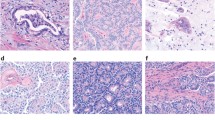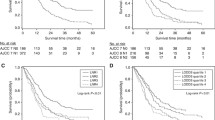Abstract
Background
Pancreatic ductal adenocarcinoma is the fifth leading cause of death among all malignancies, leading to approximately 40,000 deaths each year in Europe. The annual incidence rate for all types of pancreatic cancer is approximately nine new cases per 100,000 people, ranking it as the 11th among all cancers. Stage, grade and resection margin status are currently accepted as the most accurate pathologic variables predicting survival. All classification systems fail prognostically to distinguish between different stages. Even in patients with seemingly early tumours (T1, N0), the likelihood of relapse is high. This reflects the shortcomings of the pathologic staging to sufficiently discriminate patients with a high risk to develop tumour recurrence from those that carry a lower risk.
Results
On the other hand, none of the currently used systems includes or takes into consideration the role of disseminated tumour cells neither in the lymph nodes nor in the bone marrow. Occult residual tumour disease is suggested when either bone marrow or lymph nodes, from which tumour relapse may originate, are affected by micrometastatic lesions undetectable by conventional histopathology. For detection, antibodies against tumour-associated targets can be used to detect individual epithelial tumour cells both in lymph nodes and in bone marrow. The clinical significance of these immunohistochemical analyses is still controversial. Various monoclonal antibodies are still in use for micrometastatic detection, thus contributing to the incongruity of data and validity of results. These assays have been rarely used in patients with pancreatic carcinoma.
Conclusion
The presence or absence of lymph-node metastases can predict the likelihood of survival for most, if not all, patients with pancreatic ductal adenocancer and the likelihood that metastases will develop at distant sites.
Similar content being viewed by others
References
Greenlee RT, Hill-Harmon MB, Murray T, Thun M (2001) Cancer statistics. CA Cancer J Clin 51(1):15–36
Parkin DM, Muir CS (1992) Cancer incidence in five continents. Comparability and quality of data. IARC Sci Publ 120:45–173
Ahlgren JD (1996) Epidemiology and risk factors in pancreatic cancer. Semin Oncol 23(2):241–50
AJCC (2002) Exocrine pancreas. Cancer staging manual, 6th edn. Springer, New York, pp 157–163
UICC (1987) TNM classification of malignant tumors, 4th edn. Springer, New York
Japan Pancreas Society (1987) General rules for surgical and pathological studies on cancer of the pancreas, 3rd edn. Kanehara, Tokyo
Pantel K, Brakenhoff RH (2004) Dissecting the metastatic cascade. Nat Rev Cancer 4(6):448–456
Byrne J, Waldron R, McAvinchey D, Dervan P (1987) The use of monoclonal antibodies for the histopathological detection of mammary axillary micrometastases. Eur J Surg Oncol 13(5):409–411
Passlick B, Izbicki JR, Kubuschok B et al (1994) Immunohistochemical assessment of individual tumor cells in lymph nodes of patients with non-small-cell lung cancer. J Clin Oncol 12(9):1827–1832
Raymond WA, Leong AS (1989) Immunoperoxidase staining in the detection of lymph node metastases in stage I breast cancer. Pathology 21(1):11–15
Latza U, Niedobitek G, Schwarting R et al (1990) Ber-EP4: new monoclonal antibody which distinguishes epithelia from mesothelial. J Clin Pathol 43(3):213–219
Bussolati G, Gugliotta P, Morra I et al (1986) The immunohistochemical detection of lymph node metastases from infiltrating lobular carcinoma of the breast. Br J Cancer 54(4):631–636
Chen ZL, Perez S, Holmes EC et al (1993) Frequency and distribution of occult micrometastases in lymph nodes of patients with non-small-cell lung carcinoma. J Natl Cancer Inst 85(6):493–498
de Mascarel I, Bonichon F, Coindre JM, Trojani M (1992) Prognostic significance of breast cancer axillary lymph node micrometastases assessed by two special techniques: reevaluation with longer follow-up. Br J Cancer 66(3):523–527
Martini N, Flehinger BJ, Zaman MB, Beattie EJ Jr. (1983) Results of resection in non-oat cell carcinoma of the lung with mediastinal lymph node metastases. Ann Surg 198(3):386–397
Casson AG, Rusch VW, Ginsberg RJ et al (1994) Lymph node mapping of esophageal cancer. Ann Thorac Surg 58(5):1569–1570
Momburg F, Moldenhauer G, Hammerling GJ, Moller P (1987) Immunohistochemical study of the expression of a Mr 34,000 human epithelium-specific surface glycoprotein in normal and malignant tissues. Cancer Res 47(11):2883–2891
Pantel K, Schlimok G, Angstwurm M et al (1994) Methodological analysis of immunocytochemical screening for disseminated epithelial tumor cells in bone marrow. J Hematother 3(3):165–173
Kasper M, Stosiek P, Typlt H, Karsten U (1987) Histological evaluation of three new monoclonal anti-cytokeratin antibodies. 1. Normal tissues. Eur J Cancer Clin Oncol 23(2):137–147
Izbicki JR, Hosch SB, Pichlmeier U et al (1997) Prognostic value of immunohistochemically identifiable tumor cells in lymph nodes of patients with completely resected esophageal cancer. N Engl J Med 337(17):1188–1194
Z'Graggen K, Centeno BA, Fernandez-del Castillo C et al (2001) Biological implications of tumor cells in blood and bone marrow of pancreatic cancer patients. Surgery 129(5):537–546
Kanemitsu K, Hiraoka T, Tsuji T et al (2003) Implication of micrometastases of lymph nodes in patients with extended operation for pancreatic cancer. Pancreas 26(4):315–321
Hosch SB, Knoefel WT, Metz S et al (1997) Early lymphatic tumor cell dissemination in pancreatic cancer: frequency and prognostic significance. Pancreas 15(2):154–159
Vogel I, Kruger U, Marxsen J et al (1999) Disseminated tumor cells in pancreatic cancer patients detected by immunocytology: a new prognostic factor. Clin Cancer Res 5(3):593–599
Leemans CR, Tiwari R, Nauta JJ et al (1993) Regional lymph node involvement and its significance in the development of distant metastases in head and neck carcinoma. Cancer 71(2):452–456
Braun S, Pantel K, Muller P et al (2000) Cytokeratin-positive cells in the bone marrow and survival of patients with stage I, II, or III breast cancer. N Engl J Med 342(8):525–533
Woelfle U, Cloos J, Sauter G et al (2003) Molecular signature associated with bone marrow micrometastasis in human breast cancer. Cancer Res 63(18):5679–5684
Bogoevski D, Yekebas EF, Schurr P et al (2004) Mode of spread in the early phase of lymphatic metastasis in pancreatic ductal adenocarcinoma: prognostic significance of nodal microinvolvement. Ann Surg 240(6):993–1000 discussion 1000-1
Yekebas EF, Bogoevski D, Bubenheim M et al (2006) Strong prognostic value of nodal and bone marrow micro-involvement in patients with pancreatic ductal carcinoma receiving no adjuvant chemotherapy. World J Gastroenterol 12(40):6515–6521
Kurahara H, Takao S, Maemura K et al (2007) Impact of lymph node micrometastasis in patients with pancreatic head cancer. World J Surg 31(3):483–490
Milsmann C, Fuzesi L, Werner C et al (2005) Significance of occult lymphatic tumor spread in pancreatic cancer. Chirurg 76(11):1064–1072
Ando N, Nakao A, Nomoto S et al (1997) Detection of mutant K-ras in dissected paraaortic lymph nodes of patients with pancreatic adenocarcinoma. Pancreas 15(4):374–378
Tamagawa E, Ueda M, Takahashi S et al (1997) Pancreatic lymph nodal and plexus micrometastases detected by enriched polymerase chain reaction and nonradioisotopic single-strand conformation polymorphism analysis: a new predictive factor for recurrent pancreatic carcinoma. Clin Cancer Res 3(11):2143–2149
Demeure MJ, Doffek KM, Komorowski RA et al (1998) Molecular metastases in stage I pancreatic cancer: improved survival with adjuvant chemoradiation. Surgery 124(4):663–669
Yamaguchi K, Chijiiwa K, Torato N et al (2000) Ki-ras codon 12 point and P53 mutations: a molecular examination of the main tumor, liver, portal vein, peripheral arterial blood and para-aortic lymph node in pancreatic cancer. Am J Gastroenterol 95(8):1939–1945
Yamada T, Nakamori S, Ohzato H et al (2000) Outcome of pancreatic cancer patients based on genetic lymph node staging. Int J Oncol 16(6):1165–1171
Ridwelski K, Meyer F, Fahlke J et al (2001) Value of cytokeratin and Ca 19-9 antigen in immunohistological detection of disseminated tumor cells in lymph nodes in pancreas carcinoma. Chirurg 72(8):920–926
Niedergethmann M, Rexin M, Hildenbrand R et al (2002) Prognostic implications of routine, immunohistochemical, and molecular staging in resectable pancreatic adenocarcinoma. Am J Surg Pathol 26(12):1578–1587
Sidransky D (1997) Nucleic acid-based methods for the detection of cancer. Science 278(5340):1054–1059
Nieuwenhuis EJ, Leemans CR, Kummer JA et al (2003) Assessment and clinical significance of micrometastases in lymph nodes of head and neck cancer patients detected by E48 (Ly-6D) quantitative reverse transcription-polymerase chain reaction. Lab Invest 83(8):1233–1240
Lindemann F, Schlimok G, Dirschedl P et al (1992) Prognostic significance of micrometastatic tumour cells in bone marrow of colorectal cancer patients. Lancet 340(8821):685–689
Pantel K, Izbicki J, Passlick B et al (1996) Frequency and prognostic significance of isolated tumour cells in bone marrow of patients with non-small-cell lung cancer without overt metastases. Lancet 347(9002):649–653
Dix DB, Anderson RA, McFadden DE, Wadsworth LD (1997) Pleural relapse during hematopoietic remission in childhood acute lymphoblastic leukemia. J Pediatr Hematol Oncol 19(5):470–472
Janni W, Hepp F, Rjosk D et al (2001) The fate and prognostic value of occult metastatic cells in the bone marrow of patients with breast carcinoma between primary treatment and recurrence. Cancer 92(1):46–53
Heiss MM, Allgayer H, Gruetzner KU et al (1995) Individual development and uPA-receptor expression of disseminated tumour cells in bone marrow: a reference to early systemic disease in solid cancer. Nat Med 1(10):1035–1039
Gath HJ, Brakenhoff RH (1999) Minimal residual disease in head and neck cancer. Cancer Metastasis Rev 18(1):109–126
Neoptolemos JP, Stocken DD, Friess H et al (2004) A randomized trial of chemoradiotherapy and chemotherapy after resection of pancreatic cancer. N Engl J Med 350(12):1200–1210
Chambers AF, Groom AC, MacDonald IC (2002) Dissemination and growth of cancer cells in metastatic sites. Nat Rev Cancer 2(8):563–572
Pierga JY, Bonneton C, Vincent-Salomon A et al (2004) Clinical significance of immunocytochemical detection of tumor cells using digital microscopy in peripheral blood and bone marrow of breast cancer patients. Clin Cancer Res 10(4):1392–1400
Solakoglu O, Maierhofer C, Lahr G et al (2002) Heterogeneous proliferative potential of occult metastatic cells in bone marrow of patients with solid epithelial tumors. Proc Natl Acad Sci U S A 99(4):2246–2251
Klein CA (2002) Direct molecular analysis of single disseminated cancer cells: a prerequisite for the development of adjuvant therapies. Acta Med Austriaca Suppl 59:10–13
Klein CA, Blankenstein TJ, Schmidt-Kittler O et al (2002) Genetic heterogeneity of single disseminated tumour cells in minimal residual cancer. Lancet 360(9334):683–689
Schmidt-Kittler O, Ragg T, Daskalakis A et al (2003) From latent disseminated cells to overt metastasis: genetic analysis of systemic breast cancer progression. Proc Natl Acad Sci U S A 100(13):7737–7742
Gray JW (2003) Evidence emerges for early metastasis and parallel evolution of primary and metastatic tumors. Cancer Cell 4(1):4–6
Kuukasjarvi T, Karhu R, Tanner M et al (1997) Genetic heterogeneity and clonal evolution underlying development of asynchronous metastasis in human breast cancer. Cancer Res 57(8):1597–1604
Pantel K, Schlimok G, Braun S et al (1993) Differential expression of proliferation-associated molecules in individual micrometastatic carcinoma cells. J Natl Cancer Inst 85(17):1419–1424
Braun S, Kentenich C, Janni W et al (2000) Lack of effect of adjuvant chemotherapy on the elimination of single dormant tumor cells in bone marrow of high-risk breast cancer patients. J Clin Oncol 18(1):80–86
Albertson DG, Collins C, McCormick F, Gray JW (2003) Chromosome aberrations in solid tumors. Nat Genet 34(4):369–376
Author information
Authors and Affiliations
Corresponding author
Rights and permissions
About this article
Cite this article
Bogoevski, D., Strate, T., Yekebas, E.F. et al. Pancreatic cancer: a generalized disease—prognostic impact of cancer cell dissemination. Langenbecks Arch Surg 393, 911–917 (2008). https://doi.org/10.1007/s00423-007-0278-y
Received:
Accepted:
Published:
Issue Date:
DOI: https://doi.org/10.1007/s00423-007-0278-y




